engine coolant AUDI A7 2012 Owners Manual
[x] Cancel search | Manufacturer: AUDI, Model Year: 2012, Model line: A7, Model: AUDI A7 2012Pages: 294, PDF Size: 73.33 MB
Page 12 of 294
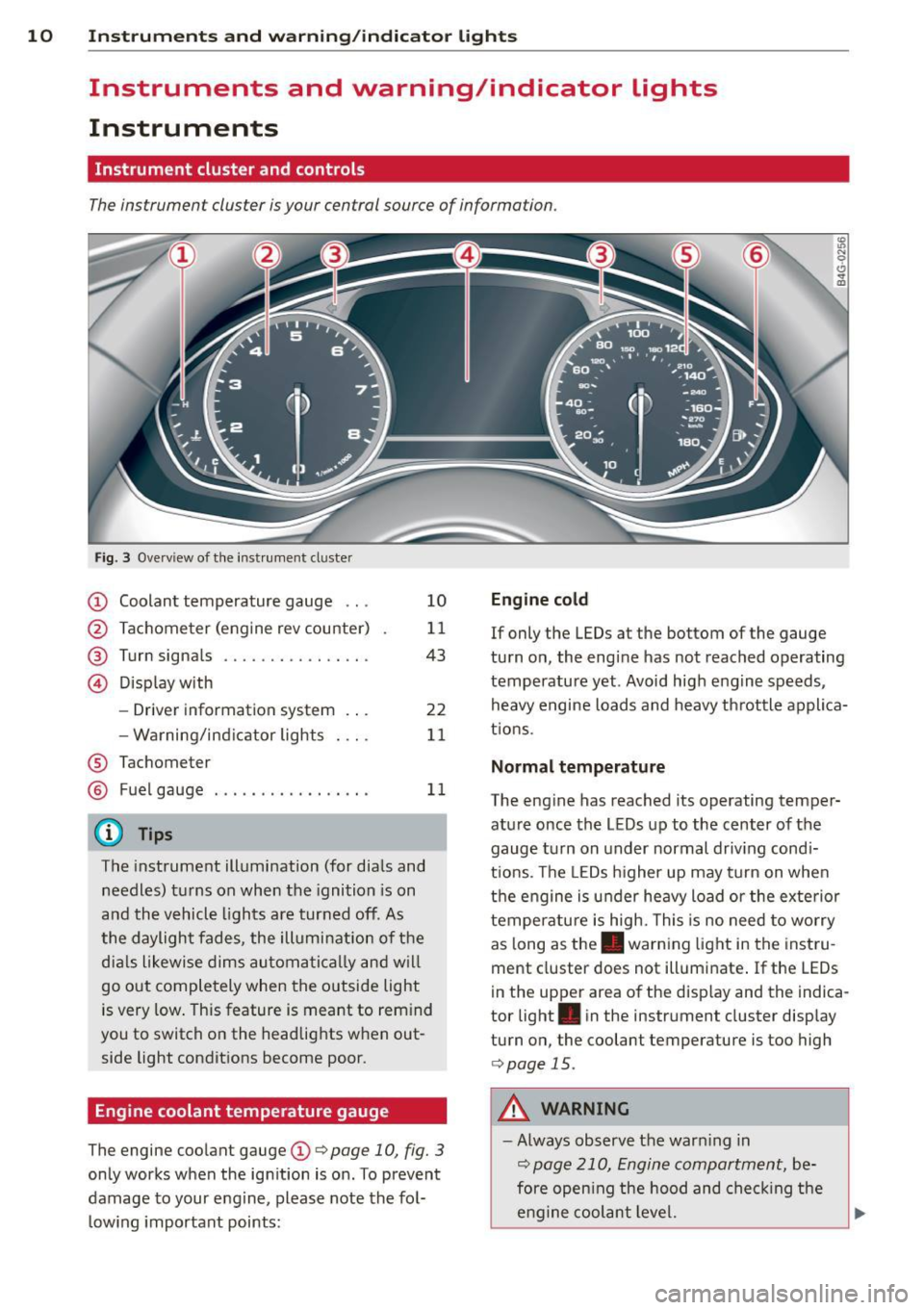
10 Instruments and warning/indicator lights
Instruments and warning/indicator Lights
Instruments
Instrument cluster and controls
The instrument cluster is your central source of information.
Fig. 3 Overv iew of the inst rument cluster
CD Coolant temperature gauge ...
@ Tachometer (engine rev counter)
@ Turn signals ........... .. .. .
© Display with
- Driver information system .. .
- Warning/ind icator lights
® Tachometer 10
11
43
22
11
@ Fuel
gauge . . . . . . . . . . . . . . . . . 11
@ Tips
The instrument illumination (for dials and
needles) turns on when the ignition is on
and the vehicle lights are turned off . As
the daylight fades, the illumination of the
dia ls likewise dims automatically and will
go out completely when the outside light
is very low. This feature is meant to rem ind
you to switch on the headlights when out
side light conditions become poor.
Engine coolant temperature gauge
The engine coolant gauge CD c:> page 10, fig. 3
only works when the ignition is on . To prevent
damage to your engine, please note the fol
l owing important points:
Engine cold
If only the LEDs at the bottom of the gauge
turn on, the engine has not reached operating
temperature yet. Avoid high engine speeds, heavy engine loads and heavy th rottle applica
t ions.
Normal temperature
The engine has reached its operating temper
ature once the LEDs up to the center of the
gauge turn on unde r normal driv ing cond i
t ions . Th e LEDs higher up may turn on when
the engine is under heavy load or the exterior
temperature is high. This is no need to worry
as long as the . warning light in the instru
ment cluster does not illuminate . If the LEDs
in the upper area of the disp lay and the indica
tor light . in the instr ument cluster display
turn on, the coolant temperature is too high
c:> page 15.
A WARNING
-Always observe the warn ing in
c:> page 210, Engine compartment, be
fore open ing the hood and checking the
engine coolant level.
Page 13 of 294
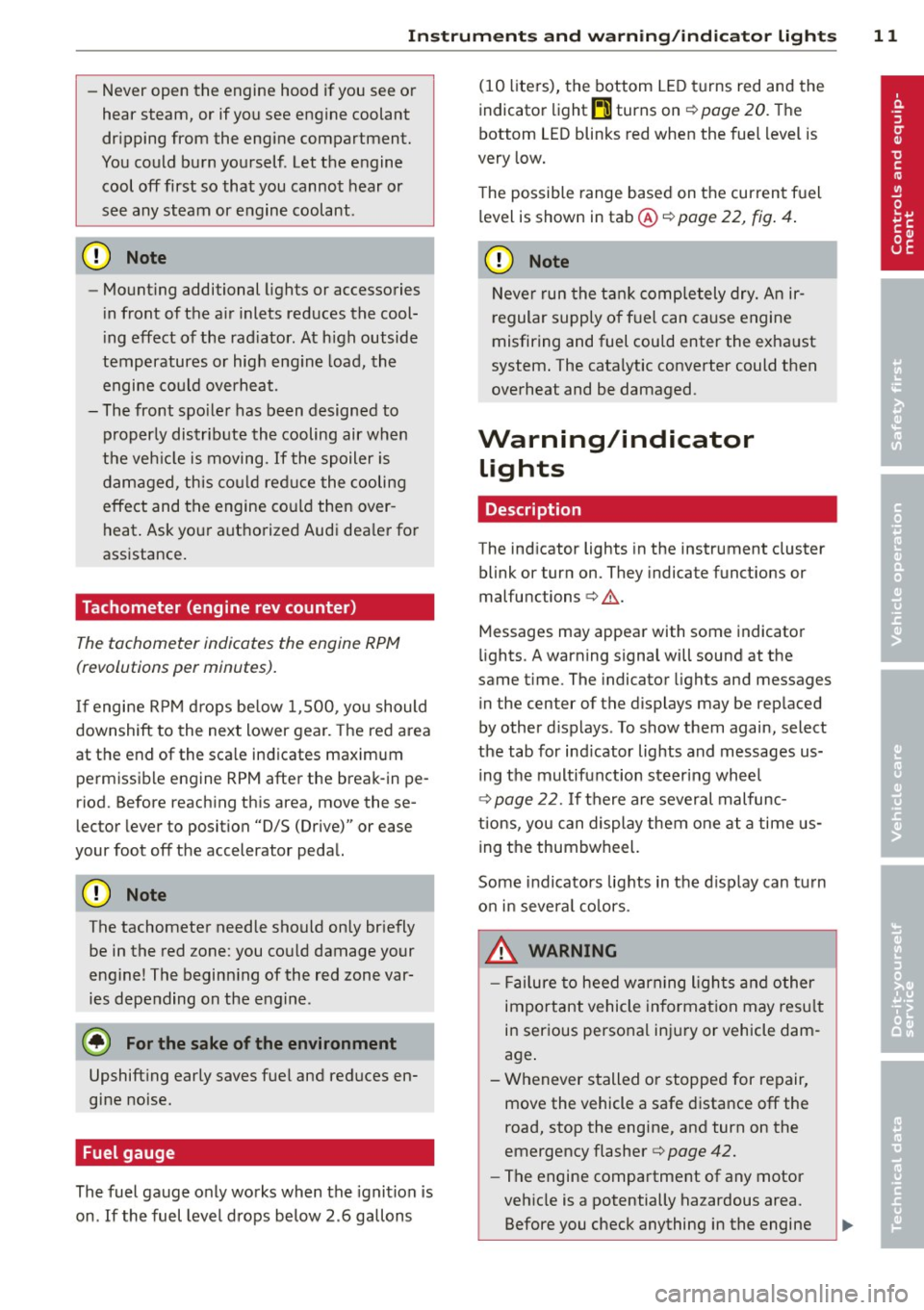
Instrument s and warnin g/indic ator ligh ts 11
- Never open the engine hood if you see or
hear steam, or if you see engine coolant
dr ipping from the engine compartment.
You could burn yourself . Let the engine
cool off first so that you cannot hear or
see any steam or engine coolant.
Q) Note
- Mount ing additional lights or accessories
i n front of the a ir inlets reduces the cool
i ng effect of the rad iator . At h igh outside
temperatures or high eng ine load, the
engine could overheat.
- The front spo ile r has been designed to
proper ly distrib ute the cooling air wh en
t h e veh icle i s moving.
If the spoiler is
damaged, this cou ld red uce the cooling
effect and the engine co uld then over
heat . Ask yo ur authorized Audi dea ler fo r
ass istance.
Tachometer (engine rev counter)
The tachometer indicates the engine RPM
(revolutions per minutes).
If engine R PM drops be low 1 ,500, you should
downshift to the next lower gea r. T he red area
at the end of the sca le indicates maximum
pe rmissib le engine RPM after the break- in pe
riod. Before reach ing this area, move these
lector lever to position "D/S (Drive)" or ease
your foot off the accelerator peda l.
(D Note
The tachometer needle should only br iefly
be in the red zone: you cou ld damage your
eng ine! The beginn ing of the red zone var
ies depending on the e ng ine.
@ For the sake of the environment
Upshift ing early saves fuel and reduces en
g ine noise.
Fuel gauge
The fuel gauge only wo rks when the ignition is
on .
If the fuel level drops below 2.6 gallons (10 liters), the bottom LED turns red and the
indicator
light~ turns on ¢
page 20. The
bottom LED blinks red when the fue l level is
very low.
T he possible range based on the current f uel
level is shown in tab@¢
page 22, fig . 4 .
(D Note
Neve r run the tan k comp letely dry. An ir
r egular supp ly o f fu el can cause engine
misfiring and fuel could enter the exha ust
system . The cata lytic converter could then
overheat and be damaged.
Warning/indicator Lights
Description
The ind icator lights in the instrument cluster
blink or turn on. They indicate funct ions or
malfunctions
q ,& .
Messages may appear with some indicato r
lights. A warning signal will sound at the
same time. The indicator lights and messages
in the center of the displays may be rep laced
by other d isplays . To show them again, select
the tab for ind icator lights and messages us
ing the multifunction steering whee l
¢
page 22. I f there are several malfunc
tions, you can display them one at a time us
ing the thumbwheel.
Some indicators lights in the d isplay can tu rn
o n in seve ra l c olors.
&_ WARNING
- F ailure to heed warning l igh ts an d other
important vehicle in formation may resu lt
in serious personal inj ury or vehicle dam
age .
- Whenever stalled or stoppe d for repair,
move the vehicle a safe d istance off the
road, stop the engine, and turn on the
emergency flasher
q page 42.
- The engine compartment of any motor
veh icle is a potentially hazardous area.
Before you check anything in the engine
Page 17 of 294
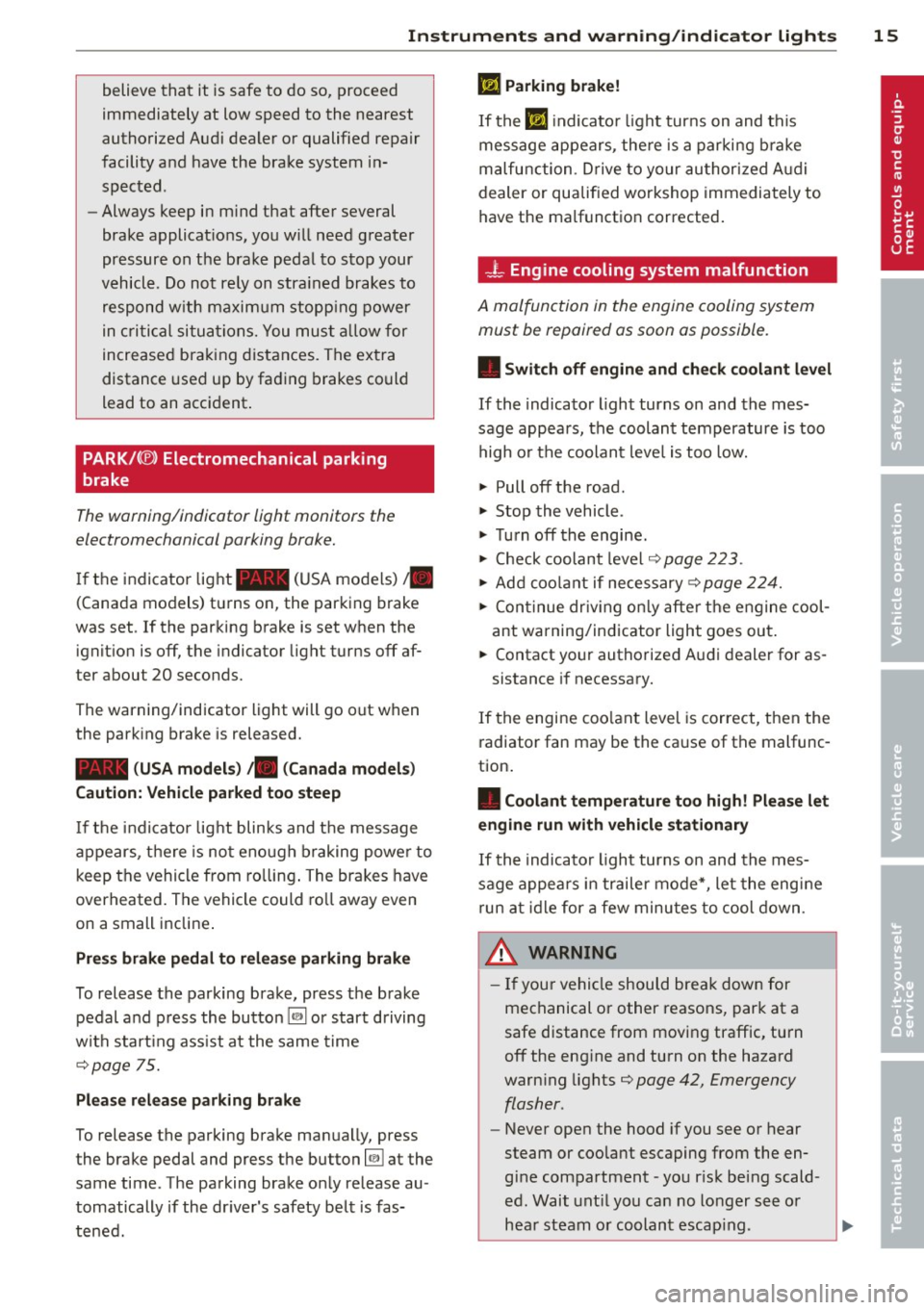
Instrument s and warnin g/indic ator ligh ts 15
believe that it is safe to do so, proceed
immediately at low speed to the nearest
authorized Audi dealer or qualified repair
facility and have the brake system i n
spected .
- Always keep in m ind that after several
brake applicat ions, you will need greater
pressure on the brake peda l to stop your
vehicle . Do not re ly on stra ined brakes to
re spond w ith maxim um stopp ing power
in cri tic al situa tions. You mus t all ow for
increased bra king distances. The extra
distance used up by fading brakes could
lead to an accident.
PARK /(®) Electromechanical parking
brake
Th e warning/indicator light monitors th e
electrome chanical parking broke.
If the indicator light- (USA models) ti
(Canada models) turns on, the parking brake
was set . If the parking brake is set when the
ignit ion is off, th@ indicator light turns off af
t er abou t 20 seconds.
The warning/indicator light will go out when
the park ing brake is released.
- (USA model s) /. (Canada model s)
Caution: Vehicle parked too steep
If the indi cator lig ht blinks and the message
appears, t here is no t eno ugh braking powe r to
keep the vehi cle from ro lling . The brakes have
overheated. The vehicle could ro ll away even
on a small incline .
Pres s brake p ed al to r elea se parkin g brake
To release the parking brake, press the b rake
pedal and p ress the button~ or start driving
with start ing ass ist a t the same time
r=.> page 75.
Pleas e release parking brake
To release the parking brake man ua lly, pre ss
t he brake pedal and press the button ~ at the
same time . The parking brake on ly release au
tomatically if the dr iver 's safety belt is fas
tened.
ll'J Parking brake!
If the ll'J indicato r light turns on and this
mess age appears , the re is a parki ng b ra ke
malfu nction . Drive to your au thori zed A udi
dealer or qualified workshop immediately to
hav e the malfunctio n corrected .
-L Engine cooling system malfunction
A malfunction in the engine cooling system
must be repaired as soon as possible.
• Switch off engine and che ck coolant level
If the indica tor l ight turns on and the mes
sage appears, the coolant temperature is too high or the coolant leve l is too low.
.,. Pull off the road .
.,. Stop the vehicle .
.,. Tu rn off th e engine.
.,. Check coolant level¢
page 223 .
.,. Add coo lant if necessary r=.> page 224.
.,. Con tinue driv ing on ly afte r the engine cool
ant warning/indicator ligh t goes out .
.,. Contact yo ur authorize d Au di d ealer for as-
s istance if necessary.
I f the engine coo lant level is correct, then the
radiator fan may be the cause of the malfunc
tion .
• Coolant temperature too high! Pl ease let
engine run with vehicle stationary
If the indicator light turns on and the mes
sage appea rs in trailer mode*, let the eng ine
run a t idl e for a few minutes to cool down .
A WARNING
- If your vehicle should brea k down for
mechanical or other reasons, park at a
safe distance from moving traffic, tu rn
off the eng ine and turn on the hazard
warn ing lights
r=.> page 42, Emergency
flasher .
-
-Never open the hood if you see or hear
steam or coola nt escaping from the en
g ine compartment -you r isk be ing scald
ed . Wait unt il you ca n no longer see o r
hea r steam o r coolant escap ing . ..,.
Page 66 of 294
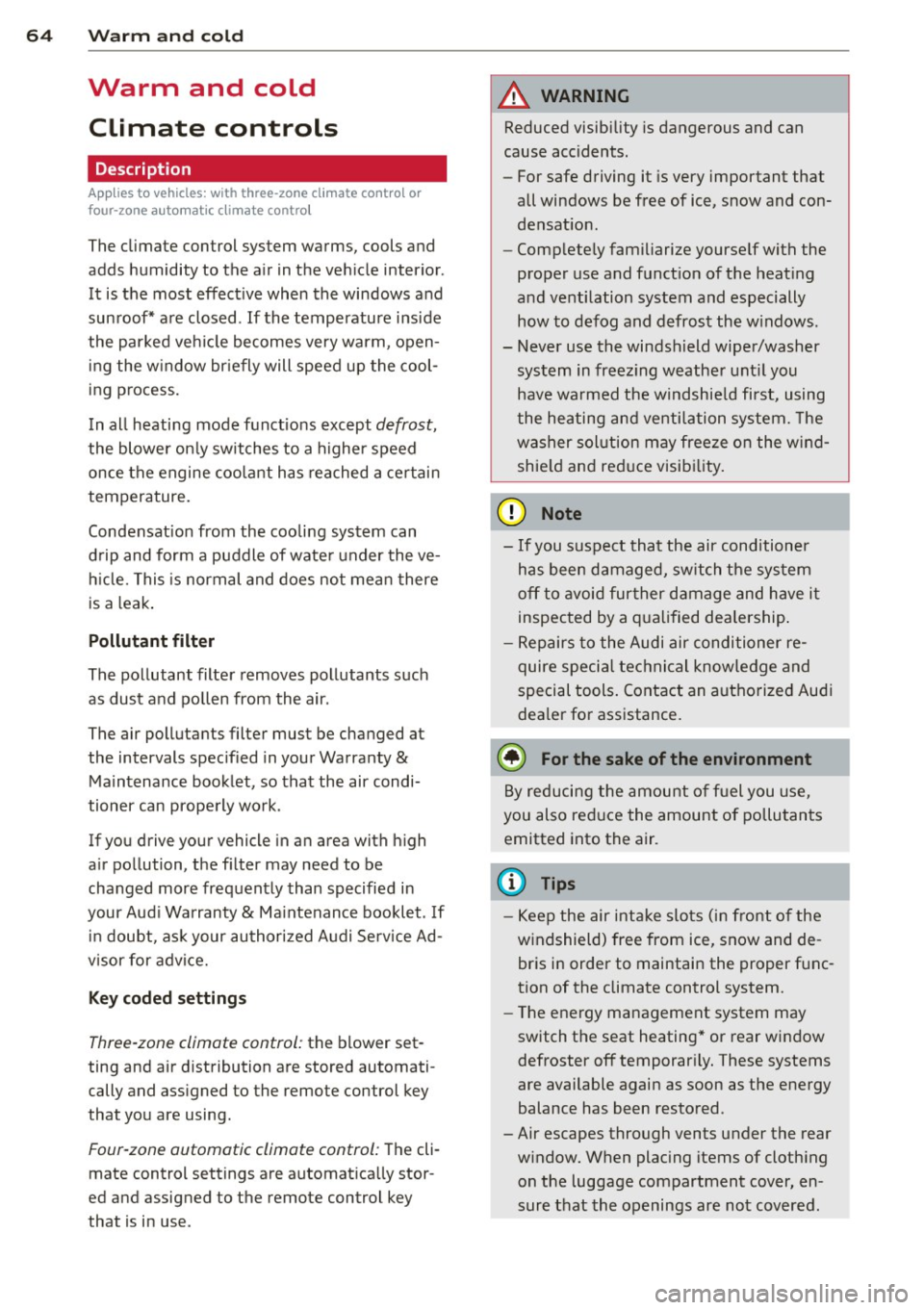
64 Warm and cold
Warm and cold
Climate controls
Description
App lies to vehicles: with three-zone climate control or
four-zone automat ic climate contro l
The climate control system warms, cools and
adds humidity to the air in the vehicle interior .
It is the most effective when the windows and
sunroof* are closed .
If the temperature inside
the parked veh icle becomes very warm, open
ing the w indow br iefly will speed up the cool
ing process.
In all heating mode functions except
defrost,
the blower on ly switches to a highe r speed
once the engine coolant has reached a certain
temperature.
Condensat ion from the cooling system can
d rip and form a puddle of wate r under the ve
h icle. This is normal and does not mean there
is a leak .
Pollutant filt er
The pollutant filter removes pollutants such
as dust and po llen from the air.
The air pollutants filter must be changed at
the intervals spec ified in your Warranty
&
Maintenance booklet, so that the air condi
tioner can properly work .
If you drive your vehicle in an area with h igh
a ir pollution, the filter may need to be
changed more freq uently than specified in
your Aud i Warranty & Ma intenance booklet . If
i n doubt, as k your author ized Audi Se rvice Ad
visor for adv ice.
K ey coded setting s
Three-zone climate control: the blower set
ting and air distribution are stored automati
cally and ass igned to the remote control key
that you are using.
Four-zone automatic climate control: The cli
mate control settings are automatica lly stor
ed and assigned to the remote control key
that is in use .
A WARNING
Reduced visibility is dangerous and can
cause accidents.
-
- For safe driving it is very important that
all windows be free of ice, snow and con
densat ion .
- Comp lete ly fami liarize yourse lf with the
proper use and funct ion of the heat ing
and venti lation system and especially
how to defog and defrost the w indows.
- Never use the windshield wiper/washer system in freez ing weather unt il you
have wa rmed the windshie ld first, using
the heating and ventilation system. The
washer sol ution may freeze on the w ind
shie ld and red uce visib ility.
(D Note
- If you suspect that the air conditioner
has been damaged, switch the system
off to avoid further d amage and have i t
inspected by a q uali fied dealership .
- Repairs to the Audi air conditioner re
quire speci al technical know ledge and
special tools. Contact an authorized Audi
dea ler fo r ass istance.
@ For the sake of the environment
By reducing the amount of f uel you use,
you also red uce the amount of pollutants
emitted into the air.
(D Tips
- Keep the air intake s lo ts (in front o f the
windshield) free from ice, snow and de
bris in order to maintain the proper func
tion of the climate control system.
- The energy management system may
switch the seat heating* or rear window
defroster off temporar ily. These systems
are available again as soon as the energy
balance has been restored .
-Air escapes through vents under the rear window. When plac ing items of cloth ing
on the luggage compartment cover, en
sure that the openings are not covered.
Page 200 of 294
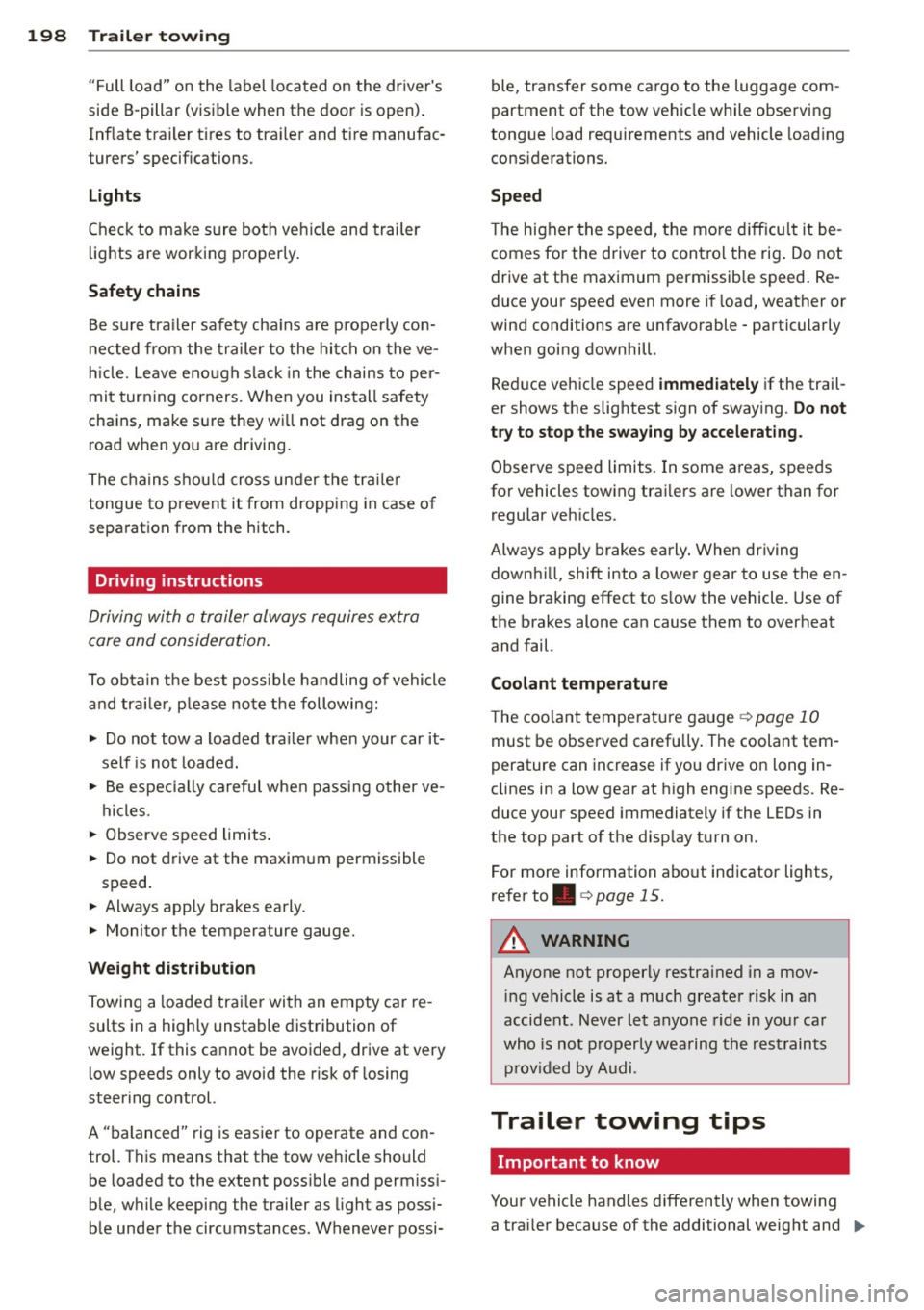
198 Trailer towing
"Full load" on the label located on the driver's
side B-pillar (visible when the door is open) .
Inflate trailer t ires to tra iler and t ire manufac
turers' specif ications.
Lights
Check to ma ke s ure bot h ve hicle and trailer
lights are working proper ly.
Safet y chains
Be sure tra ile r safety cha ins are prope rly con
nected from the trailer to the hi tch on the ve
h icle. Leave enough s lack in the chains to per
mit turning corners. When you install safety
chains, make sure they wi ll not drag on the
road when yo u are driving .
The cha ins shou ld cross under the tra ile r
tongue to prevent it from dropping in case o f
separation from the hitch.
Driving instructions
Driving with a trailer always requires extra
care and consideration .
To obtain the best poss ible handling of vehicle
and tra ile r, p lease no te the following:
.. Do not tow a loaded tra ile r when your car it
self is not loaded.
.,. Be especia lly ca reful whe n passing other
ve
hicles.
.. Observe speed limits .
.. Do not d rive at the maximum permissible
speed.
.. Always apply brakes early .
.. Monitor the temperature gauge.
W eight distribution
Towing a loaded trai le r with an empty ca r re
sults in a high ly unstable distribution of
weight . If this cannot be avoided, drive at
very
low speeds only to avoid the risk of losing
steering control.
A "balanced" rig is eas ier to operate and con
trol. This means that the tow vehicle should be loaded to the extent poss ible and permiss i
ble, while keeping the trailer as light as possi
b le under the circumstances . Whenever possi- ble, transfer some cargo to the luggage com
partment of the tow vehicle while observing
tong ue load requ irements and vehicle load ing
considerations.
Speed
T he higher the speed, the mo re d iff icu lt it be
comes for the driver to control the rig . Do not
drive at the maximum permissible speed . Re
duce your speed
even more if load, weather or
wind conditions are unfavorable -particularly
when going downhill .
Red uce vehicle speed
immediatel y if the trail
er shows the slightest s ign of sway ing.
Do not
try to stop the swaying by accelerating.
Observe speed limits. In some areas, speeds
for vehicles towing trai lers are lower than for
regular vehicles .
Always apply brakes early . When driving
down hill , shift into a lower gear to use the en
gine braking effect to s low the vehicle. Use of
the brakes alone can cause them to overheat
and fail.
Coolant temperatur e
The coo lant temperat ure gauge ¢ page 10
must be observed carefu lly. The coolant tem
perature can increase if you drive on long in
clines in a low gear at h igh engine speeds. Re
duce your speed immediately if the LEDs in
the top part of the d isp lay turn on .
For more information about indicator lights,
referto .¢page
15 .
A WARNING
Anyone not properly restrained in a mov
i ng vehicle is at a much greater risk in an
accident. Never let anyone ride in your car
who is not p roperly wea ring the rest raints
p rov ided by A udi.
Trailer towing tips
Important to know
Your vehicle handles differently when towing
a trai ler because of the additional weight and ..,.
Page 218 of 294
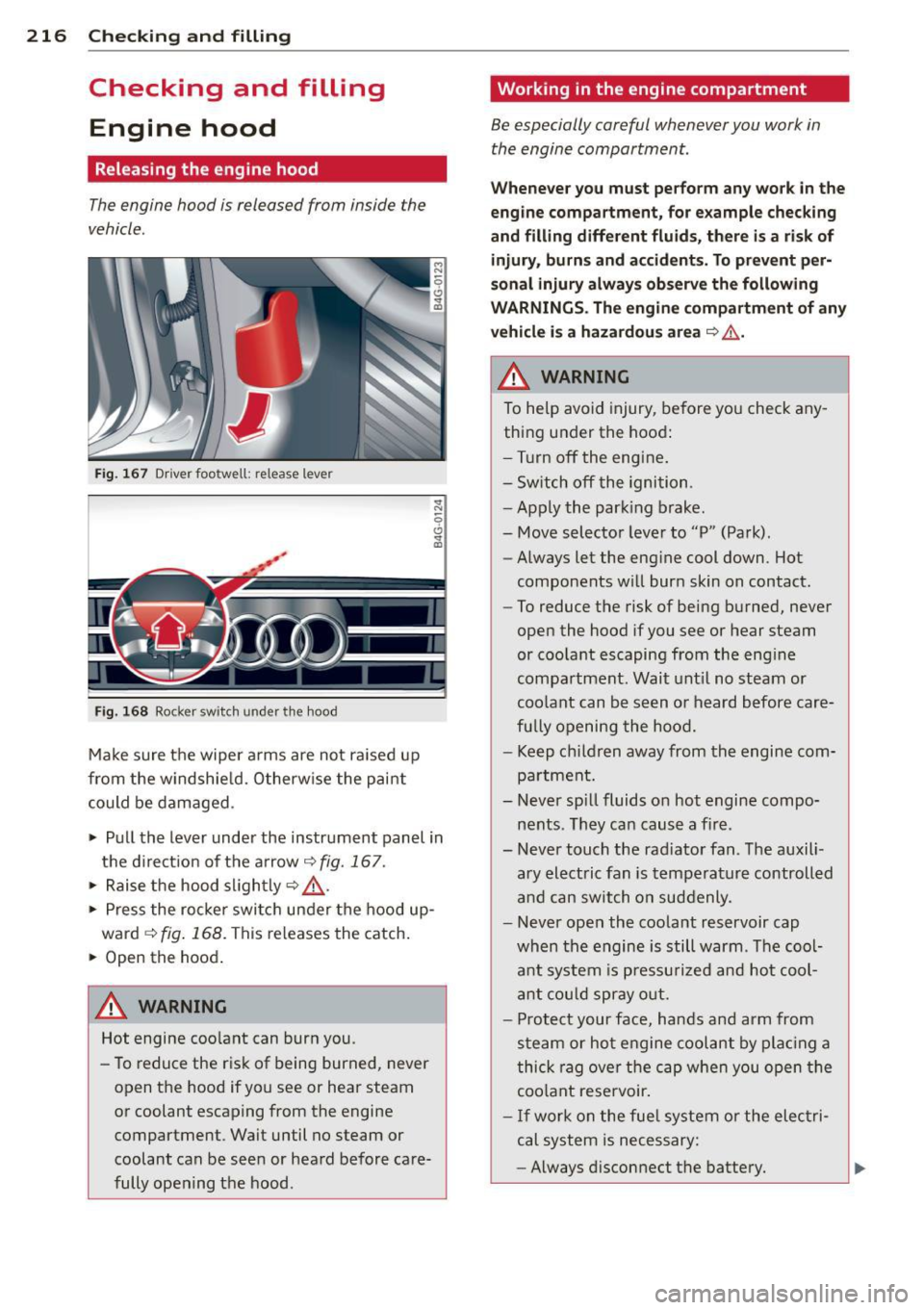
216 Checking and filling
Checking and filling Engine hood
Releasing the engine hood
The engine hood is released from inside the
vehicle .
Fig. 167 Driver foo twell: release lever
Fig. 168 Rocker switch un der the hood
Make sure the wiper arms are not raised up
from the windshield. Otherwise the paint
could be damaged.
.,. Pull the lever under the instrument panel in
the direction of the arrow
~ fig. 167.
.,. Raise the hood slightly~.&_ .
... Press the rocker switch under the hood up
ward
~ fig. 168. This releases the catch.
... Open the hood.
&_ WARNING
Hot engine coolant can burn you.
- To reduce the risk of being burned, never
open the hood if you see or hear steam
or coolant escaping from the engine compartment . Wait until no steam or
coolant can be seen or heard before care
fully opening the hood .
' Working in the engine compartment
Be especially careful whenever you work in
the engine compartment.
Whenever you must perform any work in the
engine compartment, for example checking
and filling different fluids, there is a risk of injury, burns and accidents. To prevent per
sonal injury always observe the following
WARNINGS. The engine compartment of any
vehicle is a hazardous area
~ ,&. .
/n.. WARNING
To help avoid injury, before you check any
thing under the hood:
- Turn off the engine.
- Switch off the ignition .
- Apply the parking brake.
- Move selector lever to "P" (Park) .
- Always let the engine cool down. Hot
components will burn skin on contact.
- To reduce the risk of being burned, never
open the hood if you see or hear steam
or coolant escaping from the engine
compartment. Wait until no steam or
coolant can be seen or heard before care
fully opening the hood.
- Keep children away from the engine com
partment.
- Never spill fluids on hot engine compo
nents . They can cause a fire .
- Never touch the radiator fan. The auxili
ary electric fan is temperature controlled
and can switch on suddenly .
- Never open the coolant reservoir cap
when the engine is still warm . The cool
ant system is pressurized and hot cool
ant could spray out.
- Protect your face, hands and arm from
steam or hot engine coolant by placing a
thick rag over the cap when you open the
coolant reservoir.
- If work on the fuel system or the electri
cal system is necessary:
- Always disconnect the battery.
Page 220 of 294
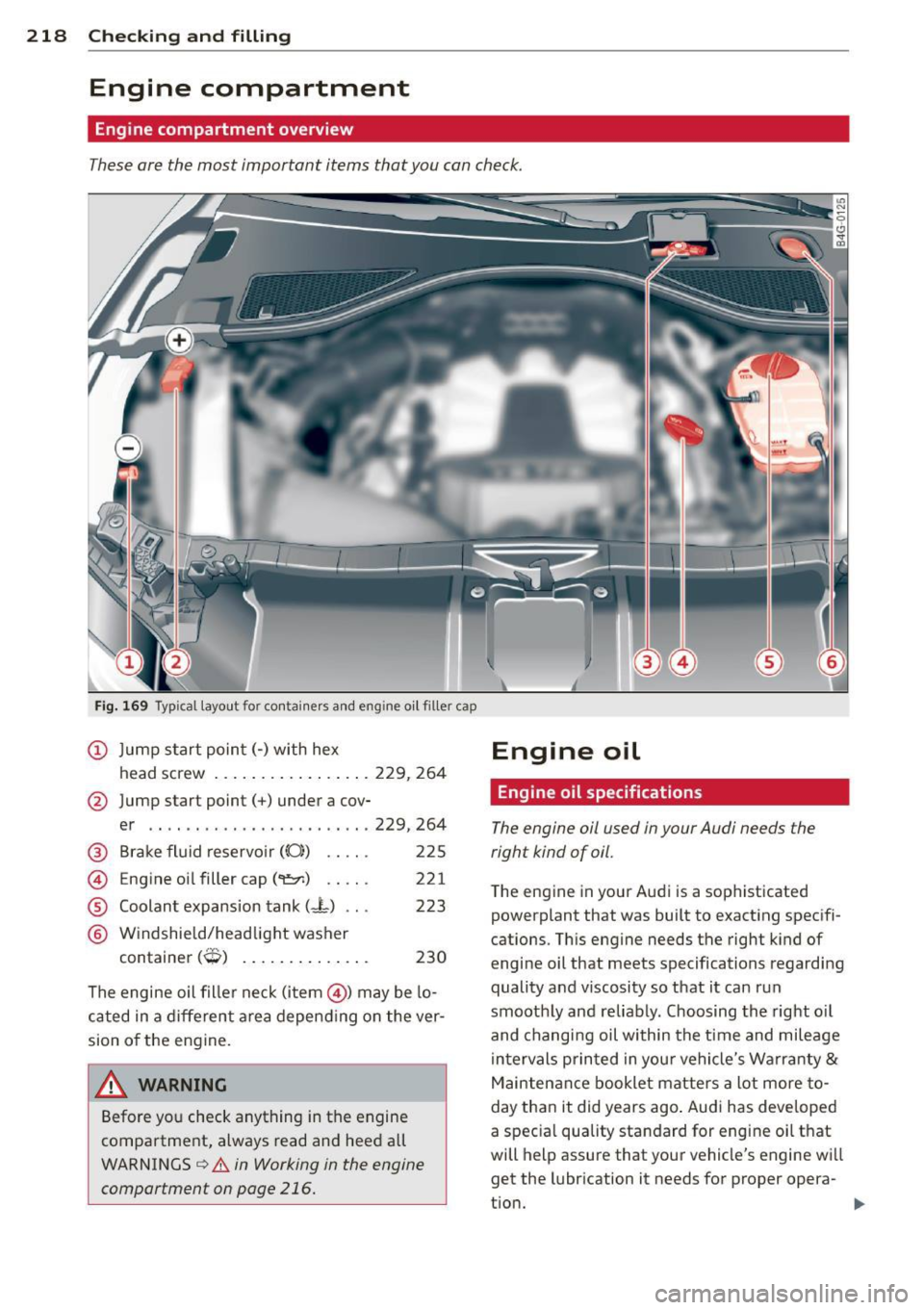
218 Checking and filling
Engine compartment
Engine compartment overview
These are the most important items that you can check.
Fig. 169 Typ ical layout for contai ners and eng ine o il filler cap
(D Jump start point(-) with hex
head screw .... ............. 229, 264
@ Jump start point(+) under a cov-
er .. .. ............... .... . 229,264
®
©
®
®
Brake fluid reservoir ((0)) . . . . . 225
Engine oil filler cap (
(-L) ...
Windshield/headlight washer
223
t . (.'R) con ainer ,,.., ............ . . 230
The engine oil filler neck (item @) may be lo
cated in a different area depending on the ver
sion of the engine.
~ WARNING
Before you check anything in the engine
compartment, always read and heed all
WARNINGS
¢ &. in Working in the engine
compartment on page 216.
-
Engine oil
Engine oil specifications
The engine oil used in your Audi needs the
right kind of oil.
The engine in your Audi is a sophisticated
powerplant that was built to exacting specifi
cations . This engine needs the right kind of
engine oil that meets specifications regarding
quality and viscosity so that it can run
smoothly and reliably . Choosing the right oil
and changing oil within the t ime and mileage
intervals printed in you r vehicle's Warranty
&
Maintenance booklet matters a lot more to
day than it did years ago . Audi has developed
a special quality standard for engine oil that
will help assure that your vehicle's engine will
get the lubrication it needs for proper opera-
tion. ..,.
Page 225 of 294
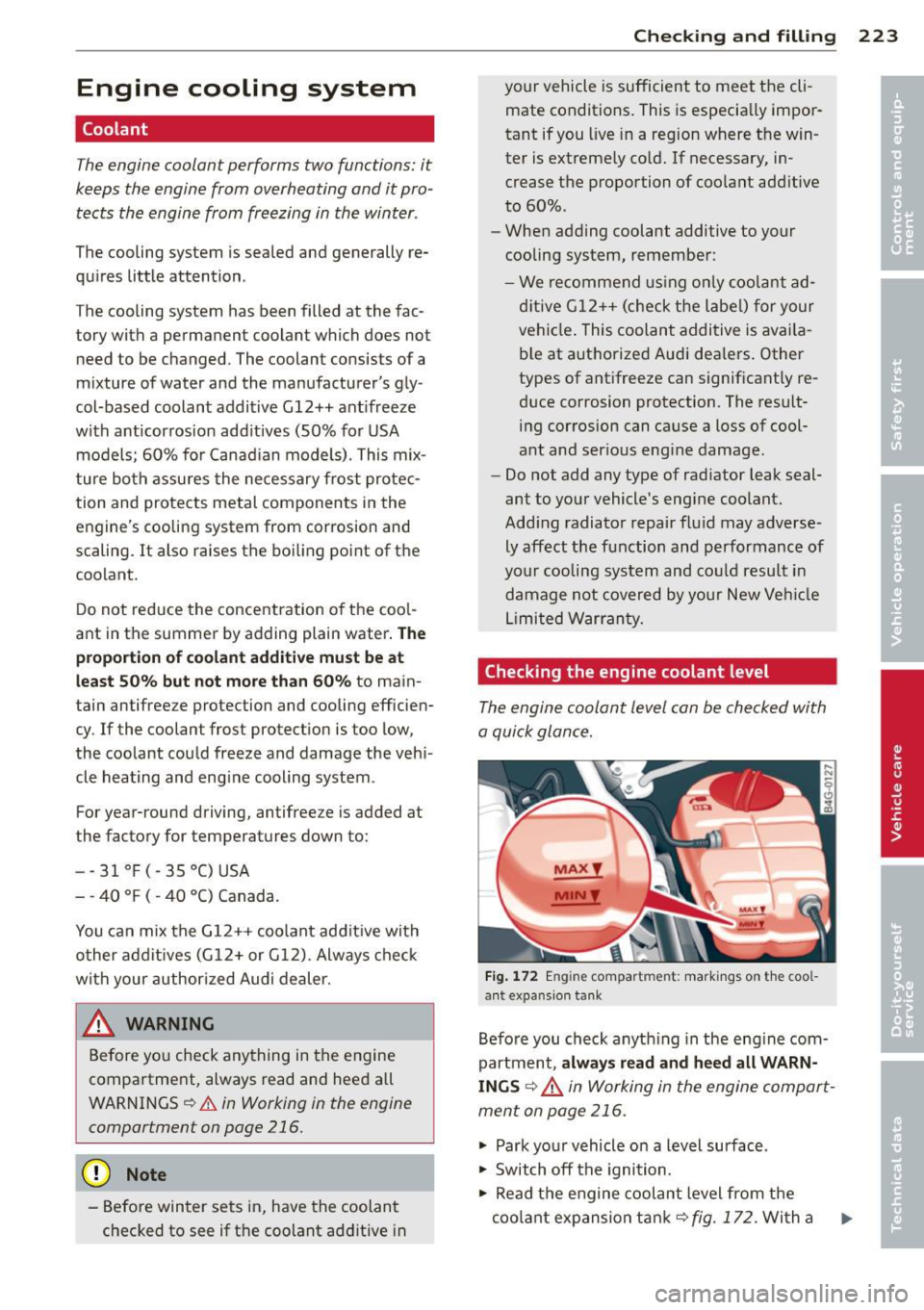
Engine cooling system
Coolant
The engine coolant performs two functions: it
keeps the engine from overheating and it pro
tects the engine from freezing in the winter .
The cooling system is sealed and generally re
quires little attention .
The cooling system has been filled at the fac
tory with a permanent coolant which does not
need to be changed. The coolant consists of a
mixture of water and the manufacturer's gly
col-based coolant additive G12++ antifreeze
with anticorrosion additives (50% for USA
models; 60% for Canadian models). This mix
ture both assures the necessary frost protec
tion and protects metal components in the
engine's cooling system from corrosion and
scaling. It also raises the boiling point of the
coolant.
Do not reduce the concentration of the cool
ant in the summer by adding plain water.
The
proportion of coolant additive must be at
least 50% but not more than 60%
to main
tain antifree ze protection and cooling efficien
cy. If the coolant frost protection is too low,
the coolant could freeze and damage the vehi
cle heating and engine cooling system.
For year-round driving, antifreeze is added at
the factory for temperatures down to:
- -31 °F ( -3 5 °C) USA
- -40 °F ( - 40 °C) Canada.
You can mix the G12 ++ coolant additive with
other additives (G12+ or G12). Always check
with your authorized Audi dealer.
& WARNING
Before you check anything in the engine
compartment, always read and heed all
WARNINGS
~ .&. in Working in the engine
compartment on page 216.
(D Note
- Before winter sets in, have the coolant
checked to see if the coolant additive in
Checking and filling 223
your vehicle is sufficient to meet the cli
mate conditions. This is especially impor
tant if you live in a region where the win
ter is extremely cold. If necessary, in
crease the proportion of coolant additive
to 60% .
- When adding coolant additive to your
cooling system, remember :
- We recommend using only coolant ad
ditive G12++ (check the label) for your
vehicle. This coolant additive is availa
ble at authorized Audi dealers. Other
types of antifreeze can significantly re
duce corrosion protection. The result
ing corrosion can cause a loss of cool
ant and serious engine damage.
- Do not add any type of radiator leak seal
ant to your vehicle's engine coolant.
Adding radiator repair fluid may adverse
ly affect the function and performance of
your cooling system and could result in
damage not covered by your New Vehicle
Limited Warranty.
Checking the engine coolant level
The engine coolant level can be checked with
a quick glance.
M AX f
MINf
Fig. 172 Engine compar tment: markings on the coo l
an t expa nsion tank
Before you check anything in the engine com
partment,
always read and heed all WARN
INGS ¢.&, in Working in the engine compart
ment on page 216 .
"' Park your vehicle on a level surface .
"' Switch off the ignition.
"' Read the engine coolant level from the
coolant expansion tank~
fig. 172. With a
Page 226 of 294
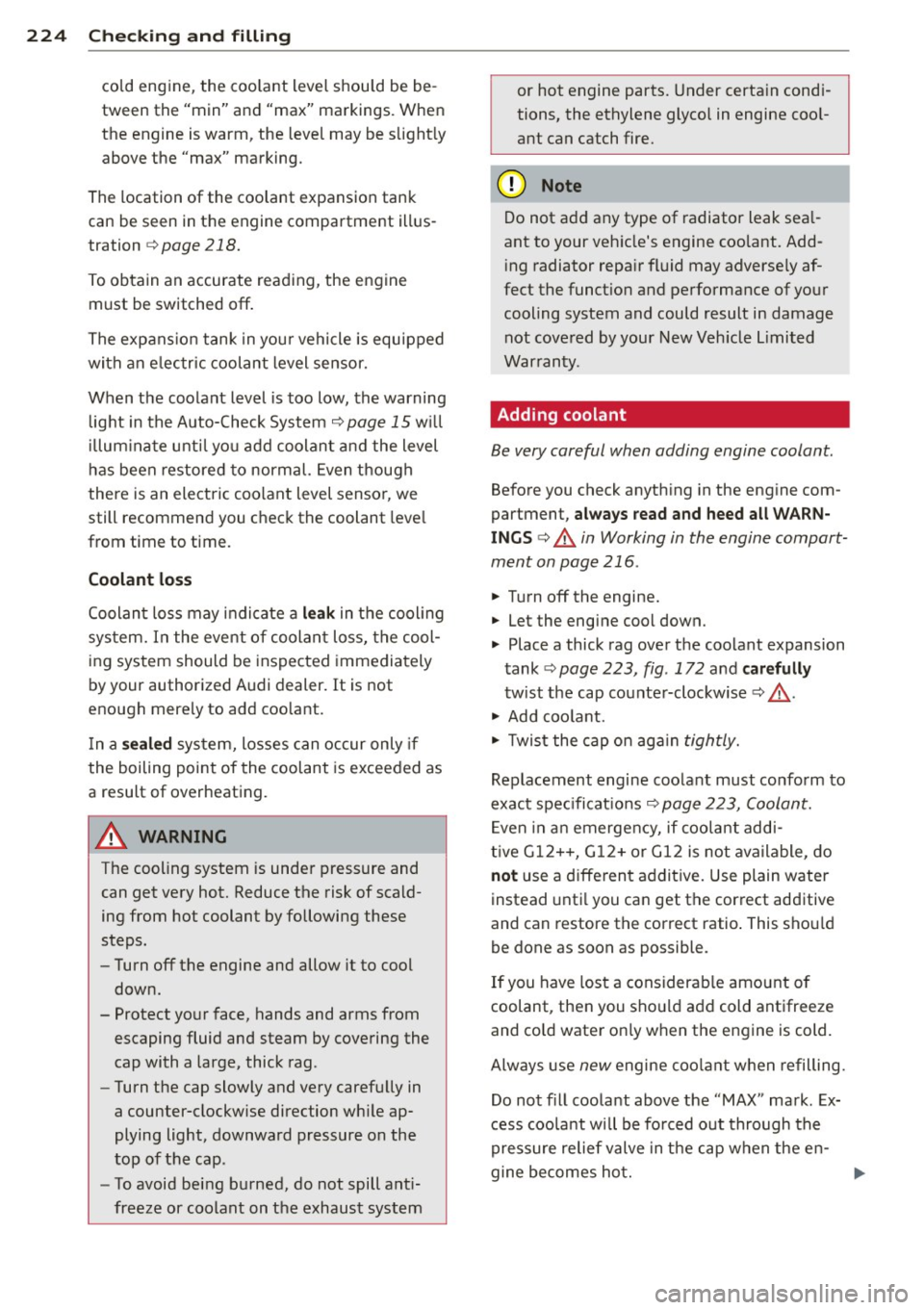
224 Check ing and filling
cold engine, the coo lant level should be be
tween the "min" and "max" markings. When
the engine is warm, the level may be s light ly
above the "max" marking.
The location of the coolant expansion tank
can be seen in the engine compartment illus
tration
c:> page 218.
To obtain an accurate reading, the engine must be switched
off.
The expansion tank in you r vehicle is equipped
with an e lectric coolant level sensor.
When the coolant level is too low, the warning light in the Auto-Check System
c:> page 15 will
i l lum ina te unti l you add coolant and the level
has been restored to normal. Even though
there is an electric coolant level senso r, we
still recommend you check the coolant leve l
from time to time.
Coolant los s
Coolant loss may indicate a leak in the cool ing
system. In the event of coolant loss, the cool
ing system should be inspected immediately
by your authorized Audi dealer. It is not
enough merely to add coolant.
I n a
sea led system, losses can occur only if
the boiling point of the coolant is exceeded as
a result of overheat ing.
A WARNING
The cooling system is under pressure and
can get very hot. Reduce the risk of scald
ing from hot coolant by following these
steps.
- Turn
off the engine and allow it to cool
down.
- Protect yo ur face, hands and arms from
escaping fluid and steam by covering the
cap with a large, thick rag.
- Turn the cap slowly and very carefully in
a counter-clockwise direction wh ile ap
plying light, downward pressure on the
top of the cap.
- To avoid be ing burned, do not spill ant i
freeze or coolant on the exhaust system
'
or hot engine parts. Under certain cond i
tions, the ethylene glycol in engine coo l
ant can catch fire.
(D Note
Do not add any type of radiator leak sea l
ant to your vehicle's engine coolant. Add i ng radiator repa ir fl uid may adverse ly af
fect the funct ion and performance of your
cooling system and could result in damage
not covered by your New Veh icle L imited
War ranty.
Adding coolant
Be very careful when adding engine coolant.
Before you check anyth ing in the eng ine com
partment,
always read and heed all W ARN
INGS c:> A in Working in the engine compart
ment on page 216 .
.. Turn off the engine.
.. Let the engine cool down.
.. Place a thick rag over the coolant expansion
tank
c:> page 223, fig . 172 and carefully
twist the cap co unte r-clockwise c:> .&, .
.,. Add coolant .
.,. Twist the cap on aga in
tightly.
Replacement engine coo lant must conform to
exact spec ificat ions
c:> page 223, Coolant.
E ven in a n emerge ncy, if coolant add i-
t ive G12 ++, G 12+ or G12 is not available, do
not use a d iffe rent addit ive. Use plain water
instead unti l you can get the correct additive
and can restore the correct ratio . This shou ld
be done as soon as possible.
If you have lost a considerab le amount o f
coolant, then you sho uld add cold antifreeze
and co ld water on ly w hen the engine is cold.
Always use
new engine coo la nt whe n refilling.
Do not fill coola nt above the "MAX" mark . Ex
cess coola nt will be fo rced out through the
pressure relief valve in the cap w hen the e n-
gine becomes hot. .,.
Page 227 of 294
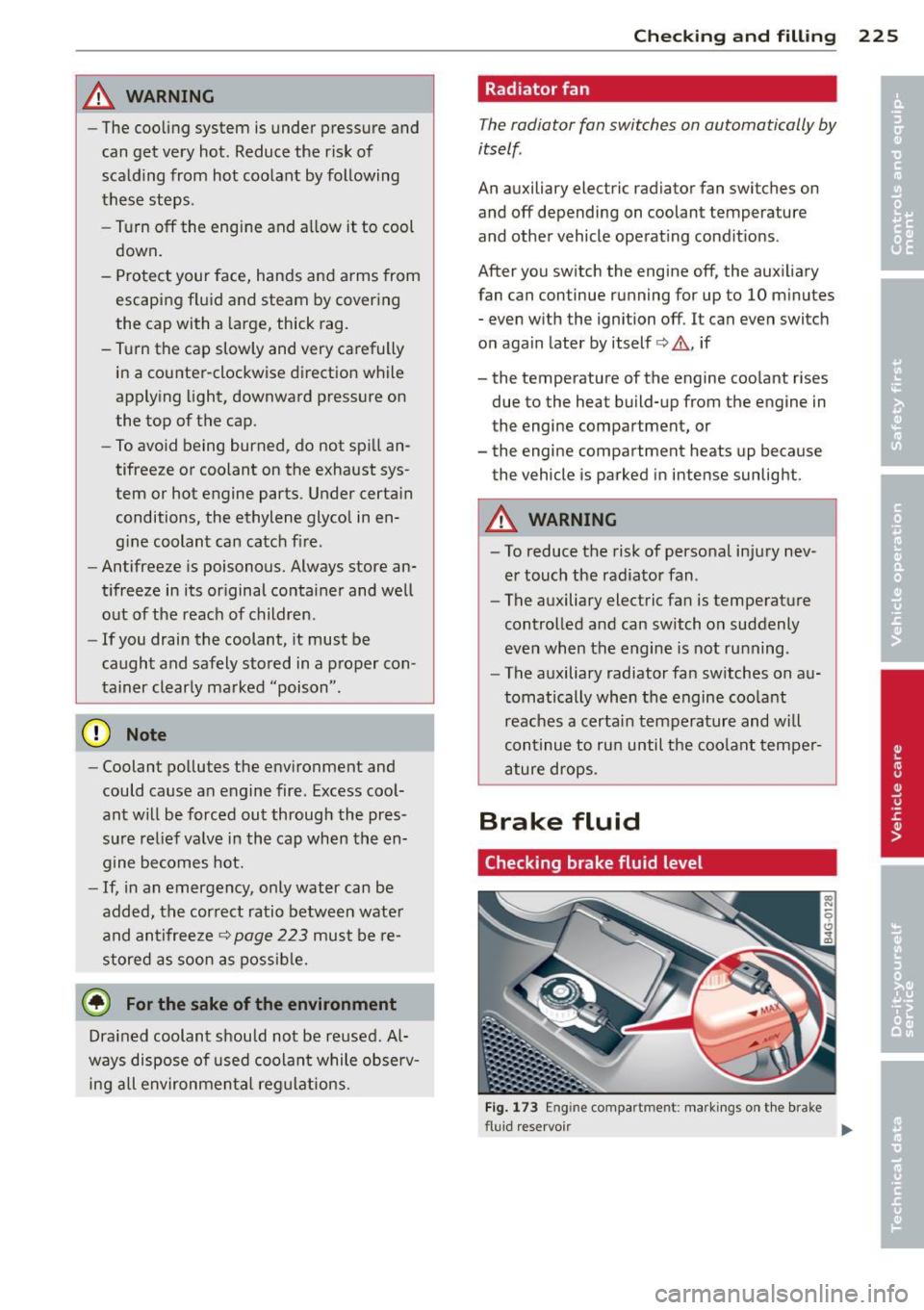
_& WARNING
-The cooling system is under pressure and
can get very hot. Reduce the risk of
scald ing from hot coolant by following
these steps.
- Turn
off the engine and a llow itto cool
down.
- Protect your face, hands and arms from
escaping fluid and steam by covering
the cap with a large, thick rag.
- Turn the cap slow ly and very carefully
in a counter-clockwise direction while
applying light, downward pressure on
the top of the cap.
- To avoid being burned, do not spi ll an
tifreeze or coolant on the exhaust sys
tem or hot engine parts . Under certain
conditions, the ethylene glycol in en
g ine coolant can catch fire .
- Antifreeze is poisonous. Always store an
tifreeze in its or iginal containe r and we ll
out of the reach of children.
- If you drain the coolant, it must be
caught and safely stored in a proper con
tainer clearly marked "poison".
(D Note
- Coolant pollutes the env ironment and
could cause an engine fire. Excess cool
ant will be forced out through the pres
su re relief valve in the cap when the en
gine becomes hot.
- If, in an emergency, only water can be
added, the cor rect ratio between water
and antifreeze ¢
page 223 must be re
stored as soon as possib le.
@ For the sake of the environment
Drained coolant should not be reused . A l
ways dispose of used coolant while obse rv
ing all environmental reg ulations.
Checkin g and fillin g 225
Radiator fan
The radiator fan switches on automatically by
itself.
An auxiliary electric radiator fan switches on
and
off depending on coolant temperature
and other vehicle operat ing cond it ions .
After you switch the engine
off, the auxiliary
fan can continue running for up to 10 minutes
- even with the ignition
off. It can even switch
on again later by itself ¢&. , if
- the temperature of the engine coo lant rises
due to the heat build-up from the engine in
the engine compartment, or
- the engine compartment heats up because
the vehicle is parked in intense sunlight.
_& WARNING
-To reduce the risk of personal injury nev
er touch the radiator fan .
- The auxiliary electric fan is temperature
controlled and can sw itch on suddenly
even when the engine is not running.
- The a uxiliary radiator fan sw itches on au
tomatically when the engine coo lant
reaches a certa in temperature and will
continue to ru n until the coolant temper
ature drops.
Brake fluid
Checking brake fluid level
Fig. 173 En gin e compartment: mark ings on th e brake
fluid rese rvoir